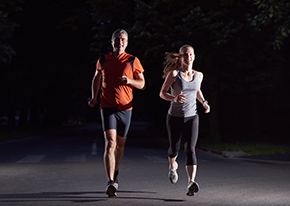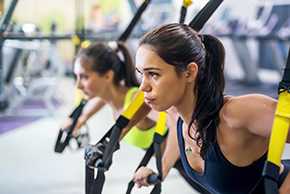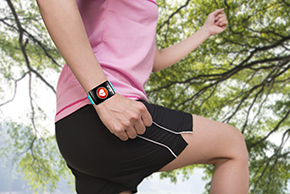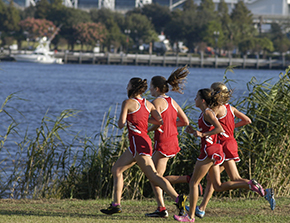Exercise Tips and Resources
These tips and resources are for athletes of all ages, skill levels and disciplines. Our goal is to help you achieve your personal athletic goals in a safe, healthy manner. Please note that the advice provided below is of a general nature; it's always a good idea to check with your health care provider before beginning any new exercise routine.
Please click on any resource below to expand it and learn more.
Tips and resources
If you find yourself in the darkness for what used to be a daylight workout:

1. Stay safe
- Invest in great lights and/or reflective gear, and stay in well-lit areas where possible.
- Tell someone what you are doing/where you are going. Or even better, take someone (even your canine comrade) with you (see below)!
- Take a few extra minutes to stretch and get warm: the colder weather and the darker setting can set athletes up for injury if inadequate time is taken to get ready for the effort.
2. Find a way to stay motivated
- A great playlist can go a long way when the darkness starts to get you down. Upbeat songs can go a long way toward keeping you motivated—if you have trouble finding the time to stay on top of the latest hits or making your own playlists, consider pre-made playlists on sites like Pandora, Amazon Prime, or iTunes. Take care to avoid too much volume—if you are outside in the dark, it can obliterate the sounds that signal oncoming traffic, etc.
- If you are working out first thing in the morning, or before you return home from work, consider getting your gear ready the night before. In other words, make it easy on yourself, so you can focus on the endorphins.
- Lighting matters when you are inside, as well. If you find yourself losing focus in the absence of your usual streaming sunbeams, consider investing in a powerful light source for your indoor workout setup.
- A workout buddy is worth his/her weight in gold. A great conversation lessens the perceived effort through distraction, and your buddy can keep you accountable for both showing up and putting in the work once you are there.
Cross-training can mix it up and add an extra spark if you find yourself becoming stagnant as the seasons change.
1. Stay safe
- If you are making a change in your exercise routine, or starting a new push toward fitness, go easy on yourself in terms of expectations on the front end. All bodies need to adjust to new routines, and going too big too early can be a setup for injuries. Ask your physician or a trainer/instructor if you have questions about techniques or intensity levels.
2. Play outside if you can
- Cross-country skiing and snowshoeing can get your heart rate up without the high speeds of downhill skiing/snowboarding, but all are great options for staying fit.
- If you are a runner/cyclist/walker, take stock of your current gear and whether it is winter-weather-friendly. Trail shoes or bike tires with better traction on wet ground, for instance, can enhance your comfort and confidence. Bicycle brakes need periodic replacement, and typically get more worn in the winter weather.
3. Mix it up with indoor options

- Consider one or more of the plethora of available options for indoor exercise. The gym contains the traditional cardio machines and weight training options, but we are also experiencing a boom of new techniques for group exercise, from spinning classes to circuit training to bodyweight exercise (TRX, etc) to CrossFit and other types of group cross-training techniques. For those more comfortable with working out at home and not attending classes, look for exercise options through YouTube and other video streaming services.

In general, fitness trackers like Fitbit, Garmin, Jawbone, and smartphone applications are a way to realize and manage your true activities throughout the day. Some offer heart rate monitoring, which shows you how hard your body is working during different kinds of exercises.
Fitness trackers can also help you track progression as you exercise. For example, if your goal is to increase how far you walk every day, or how much faster you are running as you train for a race, you can evaluate your progress from the data that the device provides.
If you're using a fitness tracker with weight loss in mind, however, be mindful that many of them will overestimate the amount of calories burned. Also, while it's a great thing to have all this information, don't let it dictate your workout all the time, either. Exercise should be enjoyable, and if you find you are getting too deep into the data or it's not fun or is causing you to not exercise anymore, then consider taking a break from the device.
The nice thing about fitness trackers is that they don't have to be expensive. Even something as simple as a $2 pedometer you attach to your shoe can provide a surprising amount of data.
This article was written by Carin Moonin and originally appeared in the Portland Monthly 2016 Kids' Health Annual magazine.

The 1972 passage of Title IX, a federal law that prevents discrimination on the basis of sex in any federally funded education program or activity, dramatically increased the number of female athletes.
It also brought a new focus on issues specific to them. One was the female athlete triad, three disorders that tended to coincide in young women:
- Low energy with or without disordered eating
- Irregular menstrual periods
- Decreased bone density
An unexplained rate of stress fractures occurring in girls participating in lean-body-focused sports, such as dance, gymnastics, figure skating and distance running, brought attention to this phenomenon. Today, health professionals have a better understanding of how these conditions are related and what can be done to treat the triad.
Historically, there was a stigma and misconception that psychiatric issues and more serious eating disorders such as anorexia or bulimia predisposed those girls to sustain fractures: In essence, they were starving themselves. However, eating disorders like these are very rare: Two to four percent of girls with female athlete triad. Health professionals now understand that much of this is unintentional and many of these young athletes are simply "underfueled."
If a girl is training more than 90 minutes per day, she needs a bare minimum of 30 calories per kilogram of body weight per day in order for her brain to release leutinizing hormone. The hormone stimulates estrogen production and ovulation, helping to maintain bone density. For example, a 130-pound girl would need a minimum of 2,700 calories daily, with the recommended intake being 45 calories per kilogram –around 4,000 calories a day.
Adolescence is also a critical time for developing bone mass. Athletes may be getting plenty of exercise, which helps in the bone department, but they also need to eat plenty of calcium-rich foods paired with foods high in vitamin D.
"If you spend your adolescent years losing bone density instead of building it, there'll be less bone in the bank when you're older," says Andrea Herzka, M.D., an orthopedic surgeon at OHSU. "It's like spending from your savings account: Even if you restart deposits, the total is less than if there hadn't been a hiatus."
Education from parents and coaches is crucial. Adolescent athletes need to understand their body needs fuel just like a car. Running on empty can cause long-term health complications such as osteoporosis (brittle bones), cardiac problems, infertility or immune system problems.
Also, keeping track of a girl's period, especially during training season, is important. If periods are irregular during training, check with your pediatrician, Dr. Herzka suggests; he or she is likely skilled in treating this disorder or, if not, can refer to adolescent health or sports medicine specialists to provide further education to both families and patients.
"Kids have a hard time thinking long-term," Dr. Herzka says. "Explaining there could be premature osteoporosis may not motivate a teen, but explaining the immediate risks of possibly breaking your tibia, hip or foot can see more realistic."
For more information about the female athlete triad, talk to your pediatrician or call OHSU Sports Medicine at (503) 494-4000.
When the winter rain starts falling in town we all know that means snow is falling in the mountains! Time to get ready for snow season. Take a moment to consider some basics of winter sports safety from the American Academy of Orthopaedic Surgeons before heading to the mountains this season.
Helmet use
The National Ski Patrol recommends wearing a helmet while skiing or snowboarding. Safety and conscientious skiing and riding should be considered the most important factors to prevent injury, while helmets provide a second line of defense against head injuries. Studies show that helmets offer considerably less protection for serious head injury to snow riders traveling more than 12-14 mph.
Sledding
All participants should sit in a forward-facing position, steering with their feet or a rope tied to the steering handles of the sled. No one should sled headfirst down a slope. Do not sit/slide on plastic sheets or other materials that can be pierced by objects on the ground. Use a sled with runners and a steering mechanism, which is safer than toboggans or snow disks.
Avoid slopes that end in a street, gravel road, drop off, parking lot, river or pond. Make sure people at the bottom have cleared the slope path before allowing another sled to go down.
Snowboarding and skiing
Warm-up the muscles that will be used in skiing with exercise activities to help prevent injury such as knee lifts, heel raises, abdominal twists and squats. When done, take a few minutes to stretch out your muscles.
Use proper ski and snowboard equipment such as properly fitting boots and adjusted bindings that attach the boots to the skis/snowboard. Bindings should only be set by a certified technician to help prevent injuries during a fall. Participants should ski on trails within his or her skill level. Obey trail closure and other warning signs. Do not go off-trail.
Prepare in advance
Think ahead and participate in preseason conditioning activities. Know your limits, terrain and conditions. Use well-lit areas when choosing evening activities. Ski or ride with a partner.
Understand sport requirements and equipment maintenance. Know the skill level required for your location.
Dress for winter
Stay dry by using 'wicking' (polyester) materials against skin. Layer clothing to increase warmth. Use protective devices such as a helmet, wrist and knee braces, and poles.
Nutrition
Properly fuel before your activity. Bring portable snacks like granola bars and apples. Take breaks to eat and drink before hunger or thirst hits.
It's important to stay safe and be prepared. Parents or adults should supervise young children during all winter downhill slope sports activities at all times. Individuals with pre-existing neurological problems may be at higher risk for injury. If you have pre-existing condition you should talk to your doctor before participating in these activities.
Introduction
This program is designed to minimize the risk of acute and overuse injuries associated with skiing. It can be implemented in about 15 minutes and no equipment is necessary. The specific exercises and stretches in this program were selected for their ability to target key areas where weakness or restriction may increase the risk of overuse injury. These exercises and stretches can be used in conjunction with current warm-up and stretching routines. They are not designed to replace current routines, only to serve as a supplement.
Narrow Stance Squat
Stand straight with feet together. Slowly bend at the knees and hips lowering into a squat, keeping the head and chest up, and heels down. Stand and repeat. Compete 3 sets of 20 repetitions.
Isometric Squat
Slowly bend at the knees and hips lowering into a squat, keeping the head and chest up, and heels down. Hold this position for 30 seconds. Repeat 4 times.
Narrow Grip Push Up
Begin in a push up position with hands directly under the shoulders. Lower to the ground keeping your elbows tight to your body and your torso and hips stable and straight. Repeat as many times as possible in 3 minutes.
Supine Row
Lay flat on your back. Take hold of a stable fixed object about an arm's length away, such as a table, bleachers, or a fixed bar. Pull your body up to the object keeping your feet on the ground and your body stable, straight and rigid. Repeat as many times as possible in 3 min. This exercise can be performed with a partner instead of a fixed object. Have the partner stand over the athlete with a wide stance. The athlete grasps the partner's hands and pulls their body up while the partner remains stationary.
Lateral Lunge
Take a wide step to the side. Bend the outside leg and lunge to that side, keeping the opposite leg straight. Lower your body until you feel a stretch through the groin. Driving off of the bent leg come back up to standing. Complete 2 sets of 10 on each leg.
DL and Alternating Lateral Hop and Zigzag Hop
With your feet kept close together jump from side to side over a line. Repeat this drill with only one foot contacting the ground at a time, alternating sides. Then complete a set of both double leg and alternating leg while moving diagonally, in a zigzag pattern. Concentrate on stability and soft landing. Each set should be 30 seconds, moving as quickly as possible while maintaining control.
Schedule an appointment
Call 503-494-4000
No referral necessary
Convenient locations
OHSU Center for Health & Healing
Building 1, 12th floor
3303 S. Bond Avenue
Portland, OR 97239
OHSU Beaverton
15700 S.W. Greystone Ct.
Beaverton, OR 97006
Gabriel Park
4411 S.W. Vermont
Portland, OR 97219
Orenco Station
6355 N.E. Cornell Rd #100
Hillsboro, OR 97124